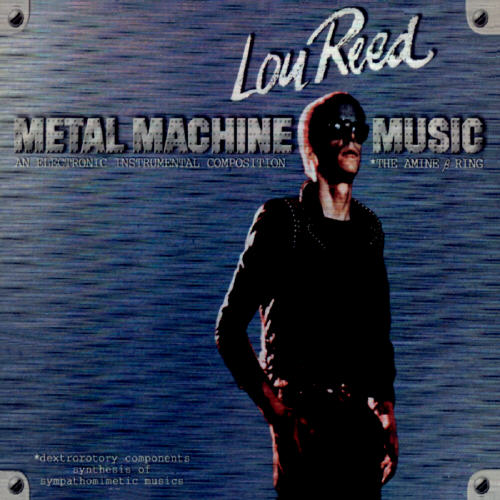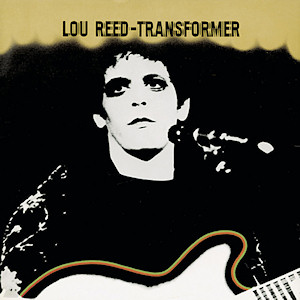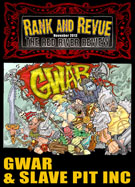When Lou Reed passed recently, I was curious to go online and see what fans and casual listeners deemed their favorite albums in his widely varied musical career. I wasn’t surprised to find the usual fondness for the Transformer or Velvet Underground and Nico albums, or even shocked that only some of the tracks were liked on those records. What is hard to understand is why some people still want to separate Reed’s darker, droning, and noisier songs, from the more melodious, melancholy and catchier ones. Both styles of his artistic personality were inseparable and to want the lighter material squirreled away into a 1990’s VH1 adult contempo category is a mystery to me. This attitude still applies to what I think is an album seminal to understanding his body of work, “Metal Machine Music, the amine b ring” (amine being a compound present in amphetamines and some tranquilizers).

Many people, critics and fans alike, when in discussing “Metal Machine Music” like to brush it off as a middle finger to RCA for a contractual obligation or attribute to Reed being purposely obtuse and contrarian to listener’s tastes. If that were true, it would render many of The Velvet Underground’s material as being one shallow and unsubstantial in-joke. Bassist and viola player John Cale came in to partnership with Reed from minimalist composer Lamonte Young’s avant garde ensemble Theatre of Eternal Music. The two had been recruiting for a recording session for a one off pop dance single on Pickwick Records. Needless to say the resulting ’45 can barely be called danceable, featuring a method called “Ostrich guitar” tuning or detuning that characterize much of the drone sound of such Velvet Underground recordings as “Venus In Furs” and “Sister Ray”.
One can also hear much of this de-tuning method influencing bands such as Swell Maps, The Fall, and Sonic Youth just to name a few. By the time the recording of “Metal Machine Music” came around, Reed was well versed in experimental noise as serious form of composition. My theory on why some people were adverse to listening to the album when it came out may be partially because it split into 4 sides over 2 records. The piece is one long composition and I can see why people may have felt they were being gypped buying an album that just sounds like the same side over and over. Now that “Metal Machine” has come out on CD that problem has been solved. The listener can hear the composition in one sitting and will notice that there are subtle changes and shifts amongst the squall and skronk. Another advantage that the modern listener has is that this record has had such an effect on such as bands like Einstuerzende Neubauten, Laibach, and even Nine Inch Nails that it doesn’t seem as radically impenetrable as it used to. If you’ve never listened to the album, or never listened to it as a continuous piece, I highly recommend giving it a chance as another great work in the late, great Lou Reed’s catalog.



Back to JAN 2014 Main Menu

Give Noise a Chance: Lou Reed’s Metal Machine Music…by Jesse Sundvall
When Lou Reed passed recently, I was curious to go online and see what fans and casual listeners deemed their favorite albums in his widely varied musical career. I wasn’t surprised to find the usual fondness for the Transformer or Velvet Underground and Nico albums, or even shocked that only some of the tracks were liked on those records. What is hard to understand is why some people still want to separate Reed’s darker, droning, and noisier songs, from the more melodious, melancholy and catchier ones. Both styles of his artistic personality were inseparable and to want the lighter material squirreled away into a 1990’s VH1 adult contempo category is a mystery to me. This attitude still applies to what I think is an album seminal to understanding his body of work, “Metal Machine Music, the amine b ring” (amine being a compound present in amphetamines and some tranquilizers).
Many people, critics and fans alike, when in discussing “Metal Machine Music” like to brush it off as a middle finger to RCA for a contractual obligation or attribute to Reed being purposely obtuse and contrarian to listener’s tastes. If that were true, it would render many of The Velvet Underground’s material as being one shallow and unsubstantial in-joke. Bassist and viola player John Cale came in to partnership with Reed from minimalist composer Lamonte Young’s avant garde ensemble Theatre of Eternal Music. The two had been recruiting for a recording session for a one off pop dance single on Pickwick Records. Needless to say the resulting ’45 can barely be called danceable, featuring a method called “Ostrich guitar” tuning or detuning that characterize much of the drone sound of such Velvet Underground recordings as “Venus In Furs” and “Sister Ray”.
One can also hear much of this de-tuning method influencing bands such as Swell Maps, The Fall, and Sonic Youth just to name a few. By the time the recording of “Metal Machine Music” came around, Reed was well versed in experimental noise as serious form of composition. My theory on why some people were adverse to listening to the album when it came out may be partially because it split into 4 sides over 2 records. The piece is one long composition and I can see why people may have felt they were being gypped buying an album that just sounds like the same side over and over. Now that “Metal Machine” has come out on CD that problem has been solved. The listener can hear the composition in one sitting and will notice that there are subtle changes and shifts amongst the squall and skronk. Another advantage that the modern listener has is that this record has had such an effect on such as bands like Einstuerzende Neubauten, Laibach, and even Nine Inch Nails that it doesn’t seem as radically impenetrable as it used to. If you’ve never listened to the album, or never listened to it as a continuous piece, I highly recommend giving it a chance as another great work in the late, great Lou Reed’s catalog.
Back to JAN 2014 Main Menu